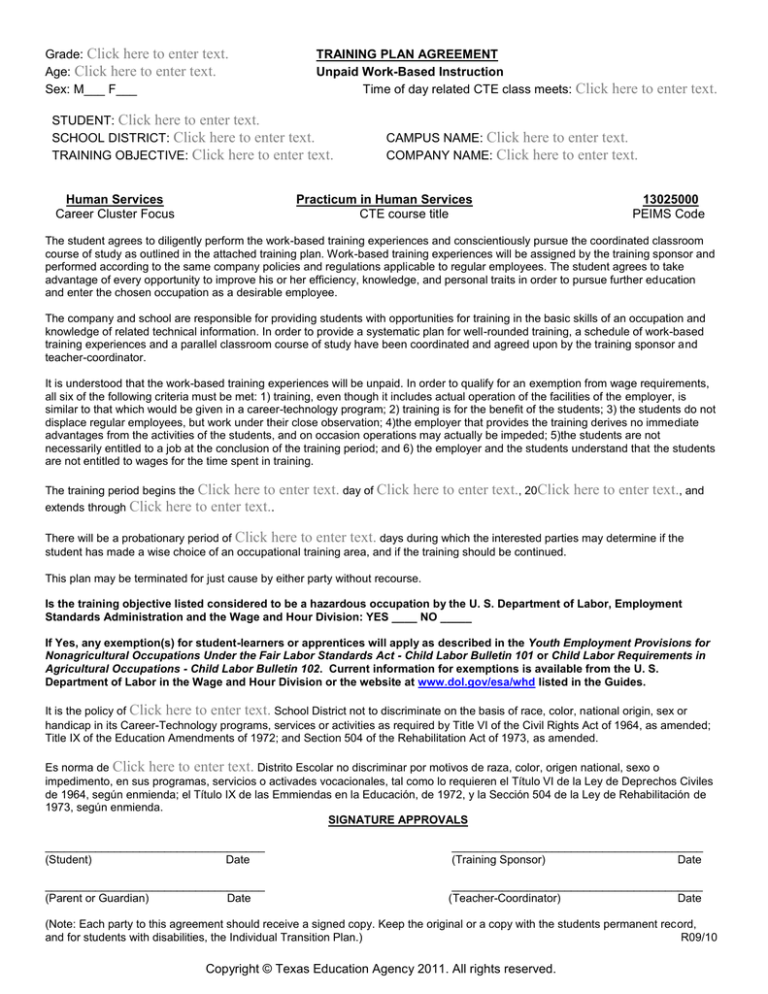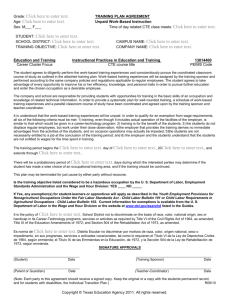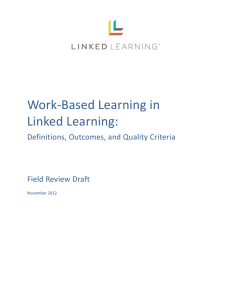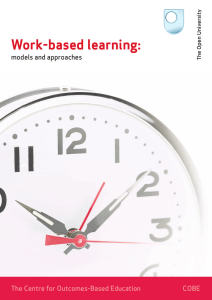
Grade: Click here to enter text.
Age: Click here to enter text.
Sex: M___ F___
TRAINING PLAN AGREEMENT
Unpaid Work-Based Instruction
Time of day related CTE class meets: Click
STUDENT: Click here to enter text.
SCHOOL DISTRICT: Click here to enter text.
TRAINING OBJECTIVE: Click here to enter text.
Human Services
Career Cluster Focus
here to enter text.
CAMPUS NAME: Click here to enter text.
COMPANY NAME: Click here to enter text.
Practicum in Human Services
CTE course title
13025000
PEIMS Code
The student agrees to diligently perform the work-based training experiences and conscientiously pursue the coordinated classroom
course of study as outlined in the attached training plan. Work-based training experiences will be assigned by the training sponsor and
performed according to the same company policies and regulations applicable to regular employees. The student agrees to take
advantage of every opportunity to improve his or her efficiency, knowledge, and personal traits in order to pursue further education
and enter the chosen occupation as a desirable employee.
The company and school are responsible for providing students with opportunities for training in the basic skills of an occupation and
knowledge of related technical information. In order to provide a systematic plan for well-rounded training, a schedule of work-based
training experiences and a parallel classroom course of study have been coordinated and agreed upon by the training sponsor and
teacher-coordinator.
It is understood that the work-based training experiences will be unpaid. In order to qualify for an exemption from wage requirements,
all six of the following criteria must be met: 1) training, even though it includes actual operation of the facilities of the employer, is
similar to that which would be given in a career-technology program; 2) training is for the benefit of the students; 3) the students do not
displace regular employees, but work under their close observation; 4)the employer that provides the training derives no immediate
advantages from the activities of the students, and on occasion operations may actually be impeded; 5)the students are not
necessarily entitled to a job at the conclusion of the training period; and 6) the employer and the students understand that the students
are not entitled to wages for the time spent in training.
The training period begins the Click
extends through Click
here to enter text. day of Click here to enter text., 20Click here to enter text., and
here to enter text..
There will be a probationary period of Click here to enter text. days during which the interested parties may determine if the
student has made a wise choice of an occupational training area, and if the training should be continued.
This plan may be terminated for just cause by either party without recourse.
Is the training objective listed considered to be a hazardous occupation by the U. S. Department of Labor, Employment
Standards Administration and the Wage and Hour Division: YES ____ NO _____
If Yes, any exemption(s) for student-learners or apprentices will apply as described in the Youth Employment Provisions for
Nonagricultural Occupations Under the Fair Labor Standards Act - Child Labor Bulletin 101 or Child Labor Requirements in
Agricultural Occupations - Child Labor Bulletin 102. Current information for exemptions is available from the U. S.
Department of Labor in the Wage and Hour Division or the website at www.dol.gov/esa/whd listed in the Guides.
It is the policy of Click here to enter text. School District not to discriminate on the basis of race, color, national origin, sex or
handicap in its Career-Technology programs, services or activities as required by Title VI of the Civil Rights Act of 1964, as amended;
Title IX of the Education Amendments of 1972; and Section 504 of the Rehabilitation Act of 1973, as amended.
Es norma de Click here to enter text. Distrito Escolar no discriminar por motivos de raza, color, origen national, sexo o
impedimento, en sus programas, servicios o activades vocacionales, tal como lo requieren el Título VI de la Ley de Deprechos Civiles
de 1964, según enmienda; el Título IX de las Emmiendas en la Educación, de 1972, y la Sección 504 de la Ley de Rehabilitación de
1973, según enmienda.
SIGNATURE APPROVALS
___________________________________
(Student)
Date
________________________________________
(Training Sponsor)
Date
___________________________________
(Parent or Guardian)
Date
________________________________________
(Teacher-Coordinator)
Date
(Note: Each party to this agreement should receive a signed copy. Keep the original or a copy with the students permanent record,
and for students with disabilities, the Individual Transition Plan.)
R09/10
Copyright © Texas Education Agency 2011. All rights reserved.
Description of Specific and Related Occupational Training
The occupational essential knowledge and skills listed below are provided as a convenience to promote quality standards in work-based training.
Additional space is available to add specific training opportunities not otherwise identified as essential knowledge and skills. NOTE: Occupational
training objectives having no state adopted essential knowledge and skills will require the training plans to be individually developed.
Essential Knowledge and Skills
for Training Objective
WorkBased
Instruction
Individualized
Class Study
(1) The student analyzes career paths within the human services industries. The
student is expected to:
(A) review careers within the human services career cluster
(B) complete a resumé;
(C) create an employment portfolio for use when applying for internships and
work-based learning opportunities in human services careers
(D) demonstrate appropriate interviewing skills to seek employment or job
shadowing experiences
(E) analyze the effects of the human services industry on local, state, national,
and global economies
(F) analyze the role of professional organizations in human services
professions
(2) The student uses oral and written communication skills and solves problems
using critical-thinking skills. The student is expected to:
(A) discuss human services research findings in everyday language keeping
instruction at an appropriate level
(B) practice effective verbal, nonverbal, written, and electronic communication
skills
(C) use communication skills such as ability to empathize, motivate, listen
attentively, speak courteously and respectfully, defuse client's anger or
skepticism, resolve conflicting interests, and respond to client objections or
complaints to the client's satisfaction
(D) apply client service techniques to complete transactions such as managing
and defusing objections with courtesy, persuading the client to agree with an
acceptable transaction, facilitating client's follow-through with the transaction,
and maintaining client relationship as client returns for services and refers
others
(E) evaluate client resources versus product costs and client risk tolerance
level such as evaluating client resources versus cost, educating client about
most beneficial choices, and recommending best products, plans, or services
for the client
(F) consult with colleagues or those knowledgeable in a field of expertise when
needed to expedite solutions to problems such as referring a client to others if
the client will be better served
(G) develop client recommendations using appropriate strategies such as
analyzing client's assets and evaluating and choosing options for maximum
return and minimum risk
(3) The student uses business tools or procedures to create human services
information and facilitate client interactions. The student is expected to:
(A) manage numerical information such as using a calculator to add, subtract,
multiply, or divide accurately
(B) perform complex calculations accurately
(C) use appropriate electronic resources to access current information
(D) use word-processing, database, spreadsheet, or presentation software to
manage data
(E) practice email applications to communicate within a workplace
(F) use specialized software to prepare needed documents accurately
(4) The student identifies how key organizational systems affect organizational
performance and the quality of products and services. The student is expected to:
(A) examine global context and all aspects of industries and careers
(B) apply principles of planning, design, development, and evaluation to
accomplish long-range goals
(C) implement quality-control systems and practices to ensure quality products
and services
(5) The student establishes a physically and psychologically healthy environment
to inspire client confidence in services provided. The student is expected to:
(A) identify locations suitable to offer human services safely such as
accessibility to transportation, safety, and security of the location
Copyright © Texas Education Agency 2011. All rights reserved.
Specific Related
Study
Assignments
Essential Knowledge and Skills
for Training Objective
WorkBased
Instruction
Individualized
Class Study
(B) incorporate a functional work environment, equipment needs, and required
utilities for offering human services
(C) create a psychologically suitable environment such as implementing
elements of a non-threatening environment or using social skills needed for a
diverse population
(D) employ emergency procedures as necessary to provide aid in workplace
accidents
(E) employ knowledge of response techniques to create a disaster and
emergency response plan
(6) The student uses leadership and teamwork skills in collaborating with others.
The student is expected to:
(A) use leadership and teamwork skills in collaborating with others to
accomplish organizational goals and objectives
(B) establish and maintain working relationships with all levels of personnel
(C) propose organizational priorities to ensure quality
(7) The student describes and observes ethical and legal responsibilities
associated with providing human services to assure the best interests of clients.
The student is expected to:
(A) model behaviors that demonstrate stewardship of client assets such as
providing beneficial help and suggestions to clients, evaluating when a client
needs an advocate, and following through with meeting these needs
(B) model ethical behaviors in the relationship with human services clients
such as offering prompt, honest, and efficient services; protecting clients from
fraud, deceit, or misrepresentation; immediately disclosing any conflicts of
interest; and making recommendations for service based on the preferences
and needs of the client
(C) comply with laws and regulations related to retail, governmental, or
private services
(8) The student selects and uses appropriate business procedures and equipment
to produce satisfying client outcomes and business success. The student is
expected to:
(A) manage funds using appropriate technology
(B) place orders for customers and supplies using sound business practices
(C) respond to client questions appropriately
(D) advise customers using appropriate and relevant information
(9) The student documents technical knowledge and skills. The student is
expected to:
Copyright © Texas Education Agency 2011. All rights reserved.
Specific Related
Study
Assignments
Essential Knowledge and Skills
for Training Objective
WorkBased
Instruction
Individualized
Class Study
Specific Related
Study
Assignments
(A) update a professional portfolio to include:
(i) attainment of technical skill competencies;
(ii) licensures or certifications;
(iii) recognitions, awards, and scholarships;
(iv) extended learning experiences such as community service and active
participation in career and technical student organizations and professional
organizations;
(v) abstract of key points of the practicum;
(vi) resumé;
(vii) samples of work; and
(viii) evaluation from the practicum supervisor
(B) present the portfolio to all interested stakeholders such as in a slide or
poster presentation
Advanced Occupationally Specific
Knowledge and Skills
Work-Based
Instruction
Individualized
Class Study
Specific Related
Study Assignments
NOTE: The above should serve as a suggested format. Space allowances should be expanded to accommodate inclusion of appropriate information.
Copyright © Texas Education Agency 2011. All rights reserved.







